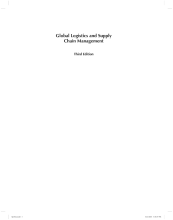Supply chain relationships
17 important questions on Supply chain relationships
From what trends is the globalisation of Supply chains arise?
- competitors, partners and customers from around the world
- global sourcing
- global presence
- global value chains resulting in increasing complexity and competition
- global access to knowledge and new technologies
- high levels of customer awareness and expectation
- rapid pace of technological change
- fast rate of product commoditisation
- SCM expertise and innovation as preconditions for business success
What is a service level agreement? (SLA)
What is an Origninal equipment manufacturer (OEM)?
- Higher grades + faster learning
- Never study anything twice
- 100% sure, 100% understanding
What is design for manufacturer (DFM)?
Why are companies mostly outsourcing?
- Reduce direct and indirect costs
- Reduce capital costs
- Reduce taxes
- Reduce logistics costs
- Overcome tariff barriers
- Provide better customer service
- Spread foreign exchange risks
- Share risk
- Build alternative supply sources
- Pre-empt potential competitors
- Learn from local suppliers, foreign customers or competitors
- Gain access to world class capabilities or attract talent globally
Why do companies offshore?
- Less strict rules in offshore region
- Lower communication and IT costs
What common causes of failures happen in outsourcing?
- Quality of products cannot be maintained
- Reliability problems between outsourcer and outsourcee
- Outsourcee not flexible enough to make changes in products
- … p.41
What order qualifiers do outsourcees have to meet?
- Reliability of delivery
- Quality certifications
- Conformance to agreed specifications
- Delivery lead time
- Financial capability
- Performance track record
- Price or cost reduction
- Senior management attitude
- Responsiveness to demand uncertainty
- Record of corporate social responsibility
What is corporate social responsibillity (CSR)?
What is the environmental seperation index? (ESI)
What are the 4 stages of the outsources-outsourcee relationship?
2. consultative stage: the outsourcer consults the oursourcee on a regular basis and low cost is not the only driver but also quality, reliability and responsivness.
3. peer to peer relationship: this is actually the perfect stage because they both collaborate and try to create a win/win relationship.
4. competitive stage: here the original outsourcee takes the lead role and starts competing with the outsourcer on global markets.
What are the differences between integration and collaboration?
Integration embodies various communication channels and linkages within a supply network, it is the alignment and interlinking of business processes.
Collaboration is a relationship between supply chain partners developed over a period of time. And integration is possible without collaboration.
Explain internal and external integration:
External intergration:
EDI is a key enabler of supply chain integration. The automated transfer of order data between supply chain partners streamlines information sharing and processing.
Effective and efficient organisational design is a prerequisite, (Ex. Leading automotive manufacturers.)
What is the keiretsu principe?
and a lean production line and is one extended operation
What are the 3 steps before reaching collaboration?
-cooperation (longer term contracts)
-coordination (information sharing)
-collaboration (technology sharing)
What is the difference between vertical and horizontal collaboration?
How can we achieve supply chain collaboration between our first tier suppliers?
-aggregated procurement ( software that decides who can produce by selecting on their capabilities)
The question on the page originate from the summary of the following study material:
- A unique study and practice tool
- Never study anything twice again
- Get the grades you hope for
- 100% sure, 100% understanding






























